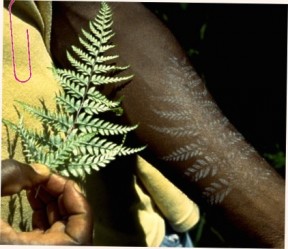
It is a girl. She is walking down an uneven path on the barren hillside, placing her feet carefully on the loose stones. Her thin brown fingers are curled around some ferns with white spore smeared undersides that she uses to stamp Christmas tree shapes on her skin. She places a leaf at the back of the hand clasping the bunch of green fronds and uses the other palm to give it a hard slap. Peeling the smashed leaf off, she smiles at the white print left behind. She turns left to enter a gap in the rough undulating stone wall that she has been following all along. A house stands there – stout and serene under an old walnut tree that has spread its arms out like a giant broccoli. The house is made of grey uncut stone slabs and has a faded red roof with the paint peeling off in places. Someone has carried large boulders to the roof and used them to pin it down so that the wind will not blow it away. This is the roof that the rain drops make music on on those stormy nights when she lies in bed with an oil lantern near her pillow, so engrossed in her reading that she doesn’t hear the wind scream.
Every afternoon, the woman with the baby in her stomach sits on the steps outside the small hut and watches the opera. It starts with the hills in the distance change colour from green to grey as the dark clouds, pregnant with rain, smash against them to dunk the place in a downpour that clogs the earth and sends the snakes slithering out of their holes. If snakes could have memories (which she has been told, they don’t) she guesses those would be different from hers. Twice she has heard the wet grass rustle and caught a glimpse of a shiny black tail even as she sat with her feet just outside the protective umbra of the roof, watching the rain drops slide down the bare skin and trickle into the clefts between her toes. The unhappy ones sometimes slip off the arch of her ankle and kill themselves by jumping into the brown muddy depth below.
If she turns her head just a little to the left, she will be able to see through the glass window, the little boy who is reading a manga comic on the computer, his plump fingers curled around the mouse. Some day she will teach him to make fern patterns on his arm. Today, she just walks in leaving wet foot prints on the floor.
Rachna Bisht-Rawat is a journalist and writer. She is also mom to a nine-year-old and gypsy wife to an Army officer whose work takes the Rawats to some of the most remote corners of India. You can read her blog at rachnabisht.com





